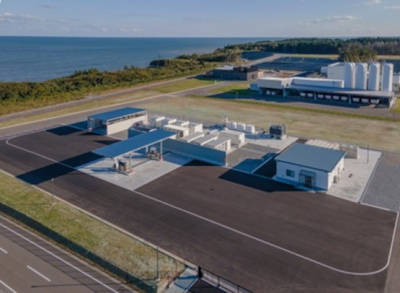Fukushima Hydrogen Refueling Technology Research Center Aims for Commercialization of HDV Refueling and Metering Technologies
Full-scale operation began in December 2022 at the Fukushima Hydrogen Refueling Technology Research Center in Namie Town, Fukushima Prefecture, part of NEDO’s Development of Technologies for Hydrogen Refueling Stations project.
The center primarily uses hydrogen produced at the adjacent Fukushima Hydrogen Energy Research Field (FH2R).
It is capable of developing and testing technologies related to high flow hydrogen refueling and metering for fuel cell-equipped heavy-duty vehicles (HDVs) and commercial transportation.
The goal of the work at the center is to achieve an HDV refueling time of approximately 10 minutes.
-
 Figure 1: The completed Fukushima Hydrogen Refueling Technology Research Center
Figure 1: The completed Fukushima Hydrogen Refueling Technology Research Center
(Left: hydrogen receiving facility, front center: hydrogen dispenser, back center: equipment installation space, right: administration building)
1. Background
Hydrogen is expected to play a central role in the future of clean energy, due to its low carbon footprint and ability to be used in various applications such as fuel cell vehicles (FCVs).
Japan’s Ministry of Economy, Trade and Industry's Hydrogen and Fuel Cell Strategy Roadmap (revised March 2019) outlined Phase 1 targets in the transportation sector for HDV and commercial vehicle hydrogen station installation. However, the development of refueling and metering technologies for HDV hydrogen stations has faced technical challenges.
It was against this backdrop that NEDO’s project, the Development of Technologies for Hydrogen Refueling Stations, took shape. From FY2020 to FY2023, the National Institute of Advanced Industrial Science and Technology (AIST), Iwatani Corporation, Tatsuno Corporation, Tokico System Solutions Co., Ltd., the Association of Hydrogen Supply and Utilization Technology, and the Japan Automobile Research Institute (JARI) worked together to advance high flow hydrogen technologies for use in HDVs.
Beginning in 2021, the project participants worked to develop and test high flow hydrogen refueling and metering technologies for HDVs at the Fukushima Hydrogen Refueling Technology Research Center located in the Tanashio Industrial Park in Namie Town, Fukushima Prefecture. It commenced full-scale operation in December 2022.
2. Description and Activities at the Center
The center is equipped with hydrogen receiving facilities capable of accommodating two trailers, four medium-pressure hydrogen compressors, two high-pressure hydrogen compressors, nine 400-liter medium-pressure hydrogen storage vessels, 27 300-liter high-pressure hydrogen storage vessels, two hydrogen dispensers, and 10 200-liter simulation containers.
The center primarily focuses on the development of the following technologies through efficient implementation of hydrogen refueling and metering tests for HDVs and simulation containers.
1) Advancing high flow hydrogen refueling technology
When hydrogen is pumped into onboard hydrogen storage tanks, the temperature rises, but the tanks are designed for a maximum operating temperature of 85°C. Although slow refueling allows heat to dissipate and reduces the temperature in the tanks, the tradeoff is time. Therefore, pre-cooling of hydrogen has been adopted. This project developed a technology that allows for fast, energy-efficient refueling by appropriately managing and adjusting the pre-cooling temperature and refueling speed of hydrogen for high flow refueling into HDVs.
2) Improving high flow hydrogen metering technology
Metering technology is essential for commercial use of hydrogen fuel. For HDVs, it is necessary to develop flow meters that can accurately measure large volumes. Flow meters can degrade over long-term use, potentially causing errors and necessitating regular inspections. Previously, the flow of hydrogen was determined by measuring the weight change of the onboard hydrogen storage tank. The flow meter was calibrated based on the difference between the tank's weight change and the flow meter's displayed value. However, this method requires large, expensive equipment to accurately measure the onboard hydrogen storage tank's weight. The goal of this project was to advance the development of a method to inspect the accuracy of flow meters installed at hydrogen stations using a portable master meter calibrated by a standard flow meter. This will allow for the use of smaller, less expensive equipment, facilitating easier and more accurate inspections.
The refueling and metering tests at the center mainly use hydrogen produced at the adjacent Fukushima Hydrogen Energy Research Field (FH2R).
By developing high flow hydrogen refueling technology, it will be possible to reduce the hydrogen refueling time for HDVs to 10 minutes, allowing for more efficient application in real-world scenarios. The development of high flow hydrogen metering technology will ensure accuracy even for HDV refueling.
The goal is to facilitate the early practical application and widespread adoption of fuel cell HDVs through the development of high flow hydrogen refueling and metering technologies at this center.
(Reference) Division of roles among project participants:
| Development of high flow hydrogen metering technology | AIST, Iwatani Corporation, Tatsuno Corporation, Tokico System Solutions Co., Ltd. |
| Maintenance and development of high flow hydrogen refueling technology at Fukushima Hydrogen Refueling Technology Research Center | Japan Automobile Research Institute, Association of Hydrogen Supply and Utilization Technology |
(Note)
* Development of Technologies for Hydrogen Refueling Stations
- Project name:
- Development of Technologies for Hydrogen Refueling Stations
- Budget: FY2022:
- 3.08 billion yen
- Project duration:
- FY2018 to FY2023
- Project overview:
- Development of Technologies for Hydrogen Refueling Stations
3. For more information, please contact:
- NEDO Smart Community and Energy Systems Department
- Tel: +81-44-520-5261
Last Updated : May 22, 2024
